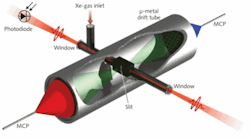ULTRAFAST-PULSE DIAGNOSTICS: Single-shot technique measures CEP for few-cycle pulses
Few-cycle-pulse researchers take heed: your experiment could soon benefit from on-the-fly, single-shot measurements of the carrier-envelope phase (CEP) as well as pulse width.
The CEP is a measure of the lag between the peak of the pulse envelope in time and the peak of the electric field. For most pulses, there is a sufficient number of cycles within the envelope that this phase lag has a negligible effect on experimental outcomes. For few-cycle pulses in high-harmonic generation and attosecond science, however, it is a critical measure.
The CEP for few-cycle pulses has been measured in the past, but only by averaging over hundreds or thousands of shots. Now, researchers at the Max Planck Institute for Quantum Optics (MPI; Garching, Germany), collaborating with colleagues in Jena, Munich, and Texas, have perfected a method to measure the CEP in a single shot. Their method relies on above-threshold ionization (ATI), which occurs when they pass few-cycle pulses through a gas cell. Above-threshold ionization is a highly field-dependent process, and photoemission due to ATI occurs in the direction of the instantaneous electric field.
This ATI emission was first used in 2001 to make an average measure of the CEP by Gerhard Paulus, then also at MPI, and colleagues from the National Institute of the Physics of Matter (Milan, Italy).1 But for applications in which an instantaneous knowledge of the CEP is necessary, such an averaged measure is not sufficient, and the recent work builds on the 2001 approach to make it a real-time, one-shot measurement.
The team splits off 10% of the output of the 4.1 fs, 400 µJ laser pulse and focuses it into a differentially vacuum-pumped drift tube, in which a xenon gas cell sits. To the left and right of the incoming beam, two slits allow ATI photoelectrons stripped off the xenon to race toward opposing time-of-flight spectrometers, detecting the electrons’ arrival times with multichannel plate detectors. To avoid stray magnetic fields, the apparatus is encased in a mu-metal (an alloy of nickel designed for its magnetic shielding properties) drift tube,.
“By comparing the precise distribution of high-energy photoelectrons emitted to the left as opposed to the right, we can determine the position of the field maximum with respect to the maximum of the pulse envelope,” explains MPI’s Adrian Cavalieri, a coauthor on the study. “This parameter contains the information governing the evolution of the electric field.”
The group thinks the approach will be a valuable add-on to high-field experiments; the measurement only requires about 40 µJ of pulse energy and could be used at repetition rates higher than 100 kHz. Further, the electron density of the xenon target will not appreciably affect the beam profile.
Tagging each pulse
“Single-shot measurement of the CEP is critical for these systems because they cannot be stabilized due to large shot-to-shot fluctuations in the phase,” Cavalieri says. “By tagging each pulse with its carrier-envelope offset phase, the corresponding measurements made with these pulses can be sorted as a function of the phase—effectively lending phase stability to these high-power laser systems.” That would give such systems a phase stability equivalent to the precision of their measurement technique, which they estimate to be 10 milliradians.2
Cavalieri cites two examples in which such shot-to-shot precision would be put to best use: high-harmonic generation from solid surfaces and laser acceleration of electrons and ions by few-cycle high-energy laser pulses.
The approach can also be used to indirectly give a pulse-width measurement—a notoriously difficult task for the shortest-pulse lasers. Because the ATI that forms the basis of the measurement is so strongly field-dependent, its cutoff can be used on either side of the peak of the field intensity to estimate pulse width. The measurement is immune to dispersion effects and has unlimited bandwidth, unlike the cumbersome measurement methods, such as frequency-resolved optical gating, that are currently used.
The team will go on to implement the phase-binning approach by in an “ATI phase meter” added onto a 20 TW, 7 fs laser at MPI, as well as on kilohertz phase-stabilized laser systems in a bid to improve their stability in attosecond-spectroscopy experiments.
REFERENCES
- Paulus et. al., Nature 414, p. 182 (2001).
- Wittman et. al., Nature Physics, DOI: 10.1038/NPHYS1250 (2009).
